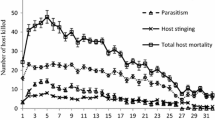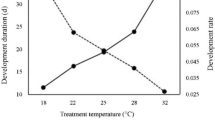Abstract
Lycorma delicatula is an invasive insect species in Korea, and its populations are increasing. It sucks plant sap and can cause withering of the whole trees. To prevent damage to fruit trees, it is important to determine the behavioral characteristics of L. delicatula. We monitored migration patterns and host plant preferences, from the egg mass on the tree bark, through egg hatching to egg laying. Most eggs hatched between 0500 h and 0800 h. The nymphs ascended trees until they reached the leaves. They often fell to the ground because of physical factors, such as wind, but then ascended the trees again on the upper sides of the branches. Their falling-ascending cycle became longer as their arolia developed. The host preference changed over the course of its growth, from a broad range of plant species at the early nymph stage to a few plant species, such as Ailanthus altissima at the adult stage. We summarize the life cycle behavior as follows. Initially, there is a short-term cycle of falling and ascending, which becomes longer as the nymphs age. The other cycle is a yearly cycle of host plant preferences, with broad host preference in the early nymph stage and a narrower host preference in the adult stage. Knowledge of this cyclic behavior can be used to prevent the rapid expansion of L. delicatula populations in orchards.









Similar content being viewed by others
References
Anderson LA, Harris A, Phillipson JD (1983) Production of cytotoxic canthin-6-one alkaloids by Ailanthus altissima plant cell cultures. J Nat Prod 46:374–378
Amirault PA, Brown NR (1986) Cone and seed insects of tamarack, Larix laricina (Du Roi) K. Koch and attempts to control damage using chemical insecticides. Can Entomol 118:589–596
Arnold JW (1974) Adaptive features on the tarsi of cockroaches (Insecta: Dictyoptera). Int J Insect Morphol Embryol 3:317–334
Bernays EA, Chapman RF (1994) Host-plant selection by phytophagous insects. Chapman and Hall, New York
Ding J, Wu Y, Zheng H, Fu W, Reardon R, Liu M (2006) Assessing potential biological control of the invasive plant, tree-of-heaven, Ailanthus altissima. Biocontrol Sci Technol 16:547–566
Frantsevich L, Ji A, Dai Z, Wang J, Frantsevich L, Gorb SN (2008) Adhesive properties of the arolium of a lantern-fly, Lycorma delicatula (Auchenorrhyncha, Fulgoridae). J Insect Physiol 54:818–827
Han JM, Kim HJ, Lim EJ, Lee SH, Kwon YJ, Cho SW (2008) Lycorma delicatula (Hemiptera: Auchenorrhyncha: Fulgoridae: Aphaeninae) finally, but suddenly arrived in Korea. Entomol Res 38:281–286
Hedlin AF, Yates HO, Cibrian-Tovar D, Ebel BH, Koerber TW, Merkel EP (1980) Cone and seed insects of north American conifers. Canadian Forestry Service, USDA Forest Service, and Secretaria de Agricultra y Recursos Hidraulicos de Mexico, Ottawa
James AP, Jesse AL (2005) Insect seasonality: circle map analysis of temperature-driven life cycles. Theor Popul Biol 67:161–179
Korea Meteorological Administration (2000) Annual climate report. http://www.kma.go.kr. Accessed on 24 October, 2009
Lee TB (1979) Illustrated flora of Korea. Hyangmunsa, Seoul
Li RZ, Tao DW (1980) Tree of heaven. Henan People’s Publishing House, Henan (in Chinese)
McClure M, Quiring DT, Turoeon JJ (1996) Oviposition, temporal distribution and potential impact of Strobilomyia laricis Michelsen and S. viaria (Huckett) (Diptera: Anthomyiidae) on eastern larch, Larix laricina (Du Roi) K. Koch. Cad Entomol 128:67–78
Ohmoto T, Koike K, Sakamoto Y (1981) Studies on the constituents of Ailanthus altissima Swingle. II. Alkaloidal constituents. Chem Pharm Bull 29:390–395
O'Reilly G, Farmer RE (1991) Phenotypic variation in cone and seed characteristics of tamarack in northwestern Ontario. Tree Planters Notes 42:18–22
Park H-H, Lee J-H (2009) Impact of pesticide treatment on an arthropod community in the Korean rice ecosystem. J Ecol Field Biol 32:19–25
Park JD, Kim MY, Lee SG, Shin SC, Kim JH, Park IK (2009) Biological characteristics of Lycorma delicatula and the control effects of some insecticides. Korean J Appl Entomol 48(1):53–57 (in Korean)
Prevost YH (2002) Seasonal feeding patterns of insects in cones of tamarack, Larix laricina (Du Roi) K. Koch (Pinaceae). For Ecol Manage 168:101–109
Sanyang F (1992) The eco-geographical distribution of forest insects in China. J Northeast For Uni 3:13–22
Schoonhoven LM, Jermy T, van Loon JJA (1998) Insect-plant biology: from physiology to evolution. Chapman and Hall, London
Song IJ (2005) Management of alien plants in Seoul. Seoul Development Institute, Seoul (in Korean)
Stephenson SL (1989) Distribution and ecology of Myxomycetes in temperate forests. II. Patterns of occurrence on bark surface of living trees, leaf litter, and dung. Mycologia 81:608–621
Turgeon JJ (1989) Spatial distribution of tamarack cones and those infested by a cone maggot, Strobilomyia sp. (Diptera, Anthomyiidae), in Ontario: Preliminary results. In: Miller GE (ed) Proceedings of the 3 rd Cone and Seed Insects Working Party Conference. Forestry Canada, Pacific Forestry Centre, Victoria, pp 181–191
Walter F, Thomas E (2004) Locomotion and adhesion: dynamic control of adhesive surface contact in ants. Arthropod Struct Dev 33:67–75
Wilson EO (1987) The little things that run the world (the importance and conservation of invertebrates). Conserv Biol 1:344–346
Xiao GR (1992) Forest insects of China. Forestry Publishing House, Beijing
Yao J, Liu Y (1993) Study on Ailanthus potyvirus. Forest Sci 39:503–508 (in Chinese)
Acknowledgements
We would like to thank Choi, Ho for helping to select host trees and for drawing the model. Comments of Marion O. Harris at North Dakota State University and Kim, Heungtae at Seoul National University on the draft greatly helped to improve the manuscript.
Author information
Authors and Affiliations
Corresponding author
Rights and permissions
About this article
Cite this article
Kim, J.G., Lee, EH., Seo, YM. et al. Cyclic Behavior of Lycorma delicatula (Insecta: Hemiptera: Fulgoridae) on Host Plants. J Insect Behav 24, 423–435 (2011). https://doi.org/10.1007/s10905-011-9266-8
Revised:
Accepted:
Published:
Issue Date:
DOI: https://doi.org/10.1007/s10905-011-9266-8




